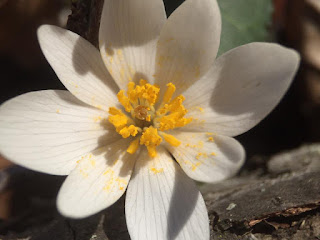Today I went The Center, in Palos Park, IL. It is a wonderful place meant to recharge you spiritually, physically, artistically, and intellectually, and any other way you might need. The main buildings are nestled into a forested hillside, with cabins dedicated for learning new art skills, and cabins for camping. Across the street they have a farm with rolling pastures, dotted with sheep, cows, donkeys, and a couple of llamas that will protect the livestock from coyotes. A barn houses clucking chickens, horses, and a couple of pigs. Here kids of all ages can learn animal husbandry skills while spending time at camp.
While hiking around, I found patches of the Spring flower, Bloodroot. Under the pictures, I have included the description given by Mrs. William Starr Dana, in her 1893 book 'How to Know the Wildflowers'.
'In early April the curled-up leaf of the Bloodroot, wrapped in its papery bracts, pushes its firm tip through the earth and brown leaves,
bearing within its carefully shielded burden, the young erect flower bud.
When the perils of the way are passed and a safe height is reached, this pale, deeply lobed leaf resigns its precious charge and gradually unfolds itself;
Meanwhile the bud slowly swells
Into a blossom
Surely no flower of the year can vie with this spotless beauty. Its very transitoriness enhances its charm.
The snowy petals fall from about their golden centre before one has had time to grow satiated with their perfection. Unless the rocky hillsides and wood-borders are jealously watched it may escape us altogether. One or two warm sunny days will hasten it to maturity, and a few more hours of wind and storm shatter its loveliness.
Care should be taken in picking the flower--if it must be picked--as a red liquid which oozes blood-like from the wounded stem makes a lasting stain. The Crimson juice was prized by the Indians as a decoration for their faces and tomahawks.'
Care should be taken in picking the flower--if it must be picked--as a red liquid which oozes blood-like from the wounded stem makes a lasting stain. The Crimson juice was prized by the Indians as a decoration for their faces and tomahawks.'













